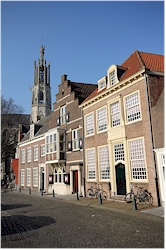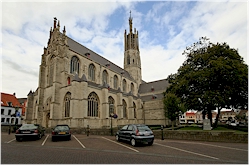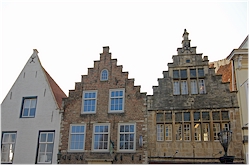
» Town
walls
» Refuge houses
» Basilica
» Town hall
» 's Landshouse
» more...

» Regional museum
» Historical evocation VVV

»
Saeftinghe

»
Reynaert De Vos
» Nieuwe Bierkaai


Picture above: nice facades on the
Market Square of Hulst
|
Hulst, the most Flemish town of the
Netherlands
 General.
Hulst
claims to be the most Flemish town of the Netherlands and this
is not only due to the fact that it's located near the Belgian
border. During the Middle Ages, the town used to be a part of
the County of Flanders and still a lot of Belgians like to make
a short excursion to Hulst during the weekends or holidays. So,
don't be surprised if you hear a lot of Flemish on one of the
many terraces that you can find on the Market Square or the
Nieuwe Bierkaai ("The New Beer Quay"). Hulst is also known as a
fortified town; it is one of the few places in the Low Countries
that managed to keep its town walls virtually intact. They now
make a nice setting for walks and this is greatly appreciated by
both inhabitants and visitors. The historic center can be found
within these mighty ramparts. Unfortunately there are quite some
younger constructions that don't fit so nicely within the
historic center. However, don't despair because if you like old
architecture then you will certainly love the Steenstraat
("Stone Street") where you can find several old houses with
impressive facades. One of the most well-known (or rather one of
the most notorious) inhabitants of the region was Reynaert De
Vos ("The Fox"). He was the main character of a centuries old
animal epos. On various places in the town but also in the
surrounding villages you can find monuments and indications to
this epic story. General.
Hulst
claims to be the most Flemish town of the Netherlands and this
is not only due to the fact that it's located near the Belgian
border. During the Middle Ages, the town used to be a part of
the County of Flanders and still a lot of Belgians like to make
a short excursion to Hulst during the weekends or holidays. So,
don't be surprised if you hear a lot of Flemish on one of the
many terraces that you can find on the Market Square or the
Nieuwe Bierkaai ("The New Beer Quay"). Hulst is also known as a
fortified town; it is one of the few places in the Low Countries
that managed to keep its town walls virtually intact. They now
make a nice setting for walks and this is greatly appreciated by
both inhabitants and visitors. The historic center can be found
within these mighty ramparts. Unfortunately there are quite some
younger constructions that don't fit so nicely within the
historic center. However, don't despair because if you like old
architecture then you will certainly love the Steenstraat
("Stone Street") where you can find several old houses with
impressive facades. One of the most well-known (or rather one of
the most notorious) inhabitants of the region was Reynaert De
Vos ("The Fox"). He was the main character of a centuries old
animal epos. On various places in the town but also in the
surrounding villages you can find monuments and indications to
this epic story.
 History.
Traces of habitation have been found in the area that date back
to before Christ. The beginning of the settlement of Hulst
itself however should be situated in the 11th
century. It received town privileges in 1180 after which the
port town was fortified with walls. One of the most important
sources of revenue was the production of salt. On several
locations in the province of Zeeland the salt trade generated
great wealth. In a time when refrigerators and freezers did not
exist yet, salt was one of the best ways to preserve food for a
longer period of time. There was an eager market for the sea
salt as an alternative to salt that was extracted from mines. It
is for good reason that it is also called the "white gold".
Hulst was located in the sphere of influence of Ghent; in the
course of the 15th
century there were several clashes with the city of Artevelde
(Ghent) resulting in the destruction of Hulst. History.
Traces of habitation have been found in the area that date back
to before Christ. The beginning of the settlement of Hulst
itself however should be situated in the 11th
century. It received town privileges in 1180 after which the
port town was fortified with walls. One of the most important
sources of revenue was the production of salt. On several
locations in the province of Zeeland the salt trade generated
great wealth. In a time when refrigerators and freezers did not
exist yet, salt was one of the best ways to preserve food for a
longer period of time. There was an eager market for the sea
salt as an alternative to salt that was extracted from mines. It
is for good reason that it is also called the "white gold".
Hulst was located in the sphere of influence of Ghent; in the
course of the 15th
century there were several clashes with the city of Artevelde
(Ghent) resulting in the destruction of Hulst.
 The
80 Years War (1568 - 1648) was crucial in the history of the
town. Hulst had an important position in the defense of Antwerp.
In order to better protect Antwerp, dikes in the wide area were
pierced to flood the countryside. In 1591 Hulst was captured by
Prince Maurits of Nassau but the Spanish managed to recapture
it. It was only at the very end of that war (in 1645 to be
precise), the northern troops managed to expel the Spanish. With
the Peace Treaty of Münster, the town was permanently attached
to the Northern Netherlands. The current border between the
Netherlands and Belgium in this area (Zeeuws-Flanders) still
largely dates back to the one determined in 1648. The
80 Years War (1568 - 1648) was crucial in the history of the
town. Hulst had an important position in the defense of Antwerp.
In order to better protect Antwerp, dikes in the wide area were
pierced to flood the countryside. In 1591 Hulst was captured by
Prince Maurits of Nassau but the Spanish managed to recapture
it. It was only at the very end of that war (in 1645 to be
precise), the northern troops managed to expel the Spanish. With
the Peace Treaty of Münster, the town was permanently attached
to the Northern Netherlands. The current border between the
Netherlands and Belgium in this area (Zeeuws-Flanders) still
largely dates back to the one determined in 1648.
Hulst
still had a connection with the (Wester) Scheldt river until the
18th
century. That access however silted up and in 1795 that meant
the end of Hulst as a port town. The fortifications around the
town were used for a while longer but they were also given up in
1816. While in many other towns, the walls and gates were
dismantled, they were (thanks to the efforts of the local
population and the town council) maintained here. Thanks to
this, Hulst is now one of the best preserved fortified towns in
the Low Countries.
Picture 1: The basilica of
Saint-Willibrordus
Picture 2: Facades in the Steenstraat
Picture 3: The historical town hall
|

» How to
get to
Hulst?
» Map of sights
» links

» Clinge
» Graauw
» Heikant
» Hengstdijk
» Hulst
» Kapellendijk
» Kloosterzande
» Kuitaart
» Lamswaarde
» Nieuw-Namen
» Ossenisse
» Sint-Janssteen
» Terhole
» Vogelwaarde
» Walsoorden
|


 General.
General.
 History.
History.
